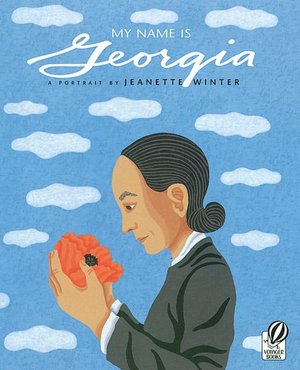It had been a long week- two nights of student-led conferences, a teacher evaluation meeting with my administrator. Add finishing report cards to that mix and preparation for MStep, and I had survived the perfect storm. Needless to say, we were tired. I needed to do something that would make our hearts sing. My students needed it, too!
So, I introduced my third and fourth graders to Georgia’s paintings. Georgia O’Keefe makes my heart sing. I began by sharing a short mini-biography I had authored, and then I read aloud My Name is Georgia by Jeanette Winter. This delightful picture book is a biography of Georgia O’Keefe. From the time she was just a young girl, Georgia O’Keeffe saw the world differently than those around her. While other girls wore braids and played with toys, Georgia practiced her drawing. She let her hair flow free. Georgia followed her love of art throughout her life. This book shows how Georgia followed her dream of becoming an artist and shared her unique vision of the world.

After sharing the book and some examples of O’Keefe’s art I found on the internet, I showed my students some photographs of natural subjects. The photos were close ups, not unlike Georgia’s flowers. We went through each photo, using the visible thinking move “See-Think-Wonder.” Using this thinking routine elevated my student’s responses. Using this routine, I first asked students to respond orally to a photo selected by me. I recorded their responses on our class response chart paper. Then I showed the other photographs and had students use “See-Think-Wonder” to discuss the photos in their small table groups. Finally, students used a “See-Think-Wonder” graphic organizer to reflect on one of the photographs of their choosing.
We got “up close and personal” with photography.
Later in the afternoon, we worked with our chosen photograph again. I modeled how to do a quick write. I viewed my photograph of yellow daffodils, and wrote single words and phrases that came into my head as I viewed it. I did a lot of thinking aloud for them, so they could hear my stream of thought. Following my lead, students wrote their own quick writes using the quick write page I provided. Then, I introduced the Pantoum poetry form. This form of poetry comes from Malaysia and employs a series of repeated lines. It’s perfect for when you want to emphasize an idea or image in your writing.
Again, I modeled taking my quick write ideas and using them to write the lines of my poem. Students followed suit, trying it on their own. My poem is below:
Spring Daffodils
In mysterious canyons of sunshine and butter,
I follow the secret pathways,
Past bends and turns
on a ruffled and rippled river.
I follow the secret pathways,
Dripping with sunlit honey.
On a ruffled and rippled river,
I ride the tumultuous waves of spring.
Dripping with sunlit honey,
Alive with bumble and buzz,
I ride the tumultuous waves of spring,
Swimming in its yellow currents.
Alive with bumble and buzz,
Past bends and turns,
Swimming in its yellow currents
In mysterious canyons of sunshine and butter.
By Tracy Willis
Later in the afternoon, we made our own poppies using templates I created and common classroom materials like scissors, glue, and construction paper. The pictures below show the results. After our crazy week, it was remarkable to listen to my students as they wrote. It was the quietest they had been all week. Even more remarkable, my boys were so earnest as they wrote their poems about Georgia’s flowers and bones. It was a Friday well spent.
I have to say, this creative writing, reading, and art activity was the perfect way to counterbalance the stresses of standardized test and student-led conferences preparation. You can find it for your own classroom by clicking the graphic below. It has everything you need to be ready for April’s Poetry Month.


